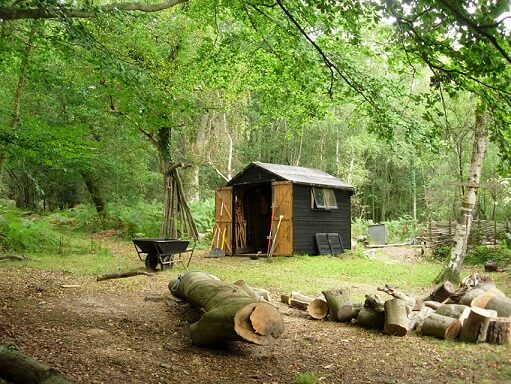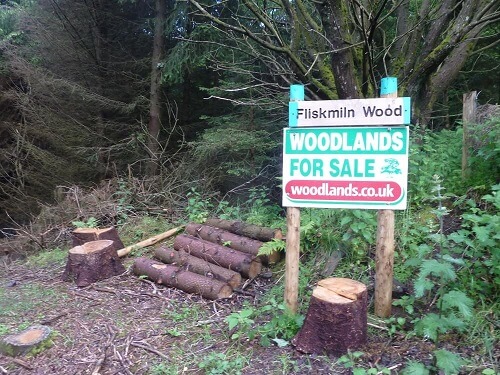Inesting in British Woodlands
Interview with Angus Hanton owner of woodlands.co.uk
Can you tell us a bit about yourself and how you came to run the website woodlands.co.uk?
It’s always been hard to find the right woodland but when my parents bought a woodland in 1972 it was almost impossible for an “amateur” to buy a small woodland. Our family bought a woodland in Sussex and it gave us enormous fun and we loved camping there as children and learning about forestry as a hobby. I still regularly visit that woodland with my parents, as do my brother and sister and our own children and they have learnt a lot about the natural world from these visits. Our children have also built dens and tree houses and dams and they know how to use edge-tools safely.
In 1988 we set up what is now Woodlands.co.uk in order to make ownership like this possible for other people – to sell nice woods of an affordable and manageable size at a fixed price so that families can enjoy the countryside in a hands-on way.
What are the main types of UK forest?
There are lots of mixed woodlands – with the trees mixed in age, as well as both evergreen and deciduous . Also we try, where possible, to sell woodlands with plenty of features – ponds, streams, slopes, benches, views and occasionally veteran trees.
What are the different reasons people buy woodlands?
Some of our buyers are motivated by commercial factors – tax-free timber income and an inheritance-tax-free asset. However, a bigger driver for most people is getting closer to nature, sourcing their own firewood and wood products (like beanpoles and Christmas trees). People like the fact that woodlands are safe and hold their value – it’s an investment you can walk through and sleep in, unlike a share portfolio.

What determines the prices of a forest?
Woodland prices are mostly determined by tree type/age and location. Typical prices are between £4,000 and £10,000 per acre and a woodland of 5 acres might cost around £35,000 to £45,000.
Why are forests in the south more expensive than the ones in the north?
There are more woods available in the North so prices aren’t generally so high as near to London but the cheapest areas are Wales and Scotland.
Looking at the valuations of forests on Woodlands.co.uk, would you say that all woodland prices have been up around 9% a year?
For the last 2-3 years prices have gone up by between 5% and 10% each year though it is hard to be scientific about prices with so many variables. The most important thing for a woodland owner may be to know that the market is more liquid than it used to be so, as long as it’s sensibly priced, you will be able to re-sell when you need to. Small woodlands are below the stamp duty threshold so the cost of the round trip – buying and selling – is much more reasonable than for larger property investments.
What are the costs that a woodland owner has?
Typically an owner spends about £90 a year for property liability insurance and perhaps in the low hundreds each year towards maintenance, though many don’t spend anything on maintenance and do any necessary work themselves.
What products/streams of income can be created from UK forests?
For larger woods owners can get significant income from timber sales and some income from letting out the shooting rights but with small woods the main benefits are in terms of what one uses oneself such as firewood, wood for making things with …. and of course the enjoyment of just being there. Some owners have rented out their woodland to users such as forest schools.
How big does a woodland need to be to be economically / commercially viable?
From a timber point of view woods that earn a return that might in purely commercial terms justify the capital costs, and have attractive economics in timber alone, are usually over 20 acres so most of our woodlands aren’t profitable in those terms, though a few of them are.
With a lower pound create more demand for UK timber?
Yes, timber prices have gone up about 20% since the referendum of 23rd June 2016. But it’s also a question of what economists call “import substitution” – woodland products that you get from your own wood are worth more because buying the same products (such as firewood or useable timber) elsewhere is now more expensive.
What are the laws around the commercial harvesting of timber for woodland?
You can cut a few cubic metres of wood each year without permission but for more significant quantities you need a feeling licence. This is given by the Forestry Commission and if you are clear-felling an area you will have to replant it.
What are the challenges to owning woodland with a hands-off approach?
Finding a good manager is critical but it’s hard to make good decisions about how to manage a woodland if you don’t know your woodland quite well.
Are there any restrictions on who can own UK farmland?
Unlike other countries the UK is remarkably open so that there are few restrictions on ownership unlike, say, Switzerland where you usually have to be both Swiss and qualified in farming to own agricultural land.
What are the services that Woodlands.co.uk offers to investors?
We offer lots of moral support to buyers after their purchase – we join them up to relevant organisations, subscribe them to the Living Woods Magazine and pay £300 towards a training course. We also introduce the buyer to other nearby woodland owners and to local forestry contractors, but woodlands.co.uk leaves the new owner totally free to decide on how to look after their woodland.
You can find out more on how to invest in British forests by visiting: Woodlands.co.uk
We thank Angus Hanton for this interview.










